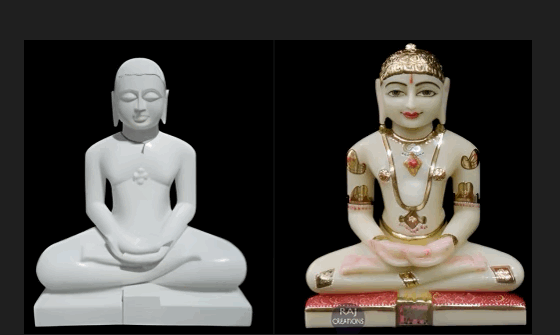Jainism, as one of the world’s oldest religions, is rooted in the principles of non-violence (ahimsa), non-possessiveness (aparigraha), and the belief in the idea that all living beings are inherently divine. However, Jainism has gradually separated into two main sects: Digambar (literally translating to “sky-clad”) and Shwetambar (literally, “white-clad). These divisions emerged from differing interpretations of the “proper” Jain lifestyle. While both sects uphold the same core philosophies, their practices and beliefs exhibit a multitude of notable differences.
One of the most prominent distinctions between Digambars and Shwetambars can be seen in their respective monastic practices. Digambar monks believe in complete renunciation to symbolize their detachment from worldly possessions; this includes not wearing any clothes, as clothing represents an attachment to material objects. Meanwhile, Shwetambar monks abstain from total nudity, and instead wear simple, white robes, denoting purity. Contrasting interpretations of “non-attachment” brought about this variation. While Digambars argue that possessing even the most minimal accessories is against Jain principles, Shwetambars maintain that one can achieve spiritual liberation without forsaking clothing entirely.
This dissimilarity carries forward–albeit in a slightly different manner–into ascetic dietary habits as well. Digambar monks (practicing the strictest form of aparigraha) do not use eating utensils, instead eating directly from their hands. In order to obtain alms, they take niyams (vows) that establish specific restrictions or characteristics pertaining to whom they will accept their food from. Until they meet someone who fulfills their predetermined requirements, they will not eat. On the contrary, Shwetambar monks typically do use bowls and other utensils to hold their food. To receive food, they go door-to-door seeking bhiksha (alms), and accept offerings from any layperson who wishes to provide it.
Laypeople also have varying approaches to idol worship depending on their sect. In Digambar tradition, idols are depicted as naked and unadorned, and are generally shown with closed eyes and serene, meditative expressions. In contrast, Shwetambar rituals involve offering various fruits and flowers to their idols, who tend to be decorated and clothed. These murtis are meticulously detailed and portray expressive facial features, reflecting the belief that such decoration does not interfere with or hinder spiritual progress. Overall, Digambars focus is placed on internal connections, while Shwetambars additionally emphasize external acts of devotion.
Furthermore, there is a significant divergence in the perceived spiritual capacity of women between sects. As per Digambar ideologies, women cannot attain moksha (liberation from the cycle of birth and death) in their current body, and must first be reborn as men in order to do so. This notion is based on the conviction that women, due to their biological and emotional nature, cannot withstand the rigor and levels of self-discipline needed for moksha. Shwetambars hold that women are equally capable of achieving liberation, and that this success is solely dependent on an individual’s purity, detachment, and devotion to the path of moksha.
The distinctions between Digambar and Shwetambar Jains reveal a rich tapestry of interpretation within Jainism. These differences not only showcase the depth of Jain philosophy, but also underscore the dynamic nature of religious framework itself. Despite their contrasting views on numerous ideals, both sects remain united in their commitment to the fundamental principles of Jainism and its teachings, reflecting a profound dedication to spiritual growth and enriching the multifaceted approach to attaining moksha.
Further Reading:
“Religions - Jainism: Jain Sects.” BBC, 11 Sept. 2009, www.bbc.co.uk/religion/religions/jainism/subdivisions/subdivisions.shtml.
“The Digambara and Svetambara Sects.” Jainworld, 19 Aug. 2022, jainworld.com/library/jain-books/books-on-line/jainworld-books-in-indian-languages/antiquity-of-jainism/the-digambara-and-svetambara-sects/.
“Understanding the Sects and Schools of Jainism.” Unacademy, 22 Aug. 2022, unacademy.com/content/bpsc/study-material/history/understanding-the-sects-and-schools-of-jainism/.


